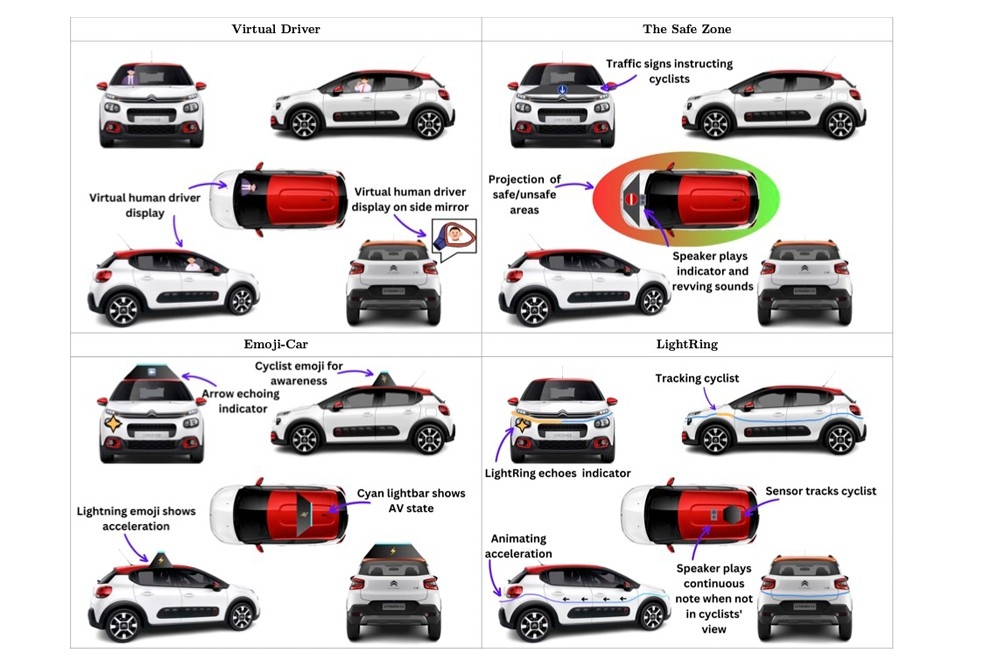Introducing the LightRing and the emoji-car ...!

Displays on the exteriors of self-driving cars could help cyclists and pedestrians stay safer on the roads of the future, researchers say
Research by academics at the University of Glasgow, suggests that LEDs displays could be one way for autonomous cars to communicate with cyclists and pedestrians. The work opens up the possibility of a new market for LEDs and other digital displays for use on the outside of self-driving vehicles.
Stephen Brewster, of the University of Glasgow’s School of Computing Science, led the research. He said: “There’s an urgent need to develop clear and consistent ways for cyclists to interact with autonomous vehicles, which are set to be a common sight in the future.
“Currently, self-driving cars lack the ability to communicate with cyclists with anything close to that level of detail or nuance, which could make cycling, scootering and wheeling much more dangerous unless we find a way to reproduce that dialogue.
“External human-machine interfaces, or eHMIs, like digital displays on the outside of vehicles are one promising solution to that problem. However, research into what forms these should take has been lagging behind the other technological developments of autonomous vehicles. With this study, we set out to develop some ideas that could lead to a new language for eHMIs to enable communication between road users.”
The researchers gathered 12 volunteers in a car park to consider how autonomous vehicles might communicate with cyclists in different traffic scenarios, with bikes placed anywhere around the car. The researchers grouped the results of their consultations into four suggestions of new ways autonomous vehicles could communicate with cyclists, which they called ‘LightRing’, ‘virtual driver’, ‘the safe zone’, and ‘emoji-car’ .
The LightRing would use a band of LEDs wrapped around the body of the car paired with a sensor on the vehicle’s roof. The LightRing would use colours and animations to communicate with pedestrians as well as cyclists. The car could signal proximity awareness by displaying an amber patch that grows as people get closer. Intentions to change speed could be accompanied by strokes of light that get faster as the car speeds up and slow down in the opposite direction as it decelerates.
The emoji-car design would use a roof-mounted display of a similar size those found on taxis to display emoticons to communicate with cyclists. Left and right arrows would echo indicators on the car and lightning symbols would show intent to accelerate.
The virtual driver concept would embed displays in autonomous vehicles’ windscreens, side windows and mirrors. Those displays would show cyclists a digital avatar of a human driver. The avatar would use their hands and head to gesture using the social cues that bike riders are currently accustomed to exchanging with real drivers without cyclists having to learn any new methods of communication.
In the safe zone concept, displays on autonomous vehicles’ exteriors would display traffic signs to advise riders if the car was going to yield or proceed. The cars would also project colours onto the road around them, with green areas safe for cyclists to enter and red spaces where cyclists should avoid.
Ammar Al-Taie, also of the University of Glasgow’s School of Computing Science, is a co-author of the paper. He added: “Our consultations helped us develop a useful taxonomy of eHMI features for cyclists that we hope can help inform the design of future communication features on autonomous vehicles."
Brewster added: “Our research on this is still ongoing, and we’re keen to refine our ideas further in real world settings. We’re currently working on experiments to test prototypes of these eHMI designs on the road with cyclists to determine their effectiveness, and we hope to publish those results in the months to come.”
The team’s paper, titled ‘Pimp My Ride: Designing Versatile eHMIs for Cyclists’, will be presented at the AutoUI ’23 conference in Ingolstadt, Germany.


































